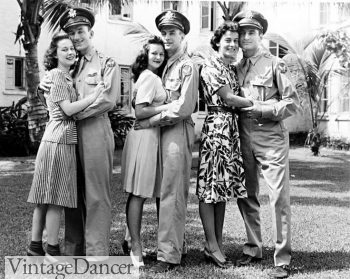
1940s couples with men in uniform
Ever since the stock market crash of 1929 and the severe economic depression that followed for most of the 1930s, fashion had been an escape. Looking to the movies, women and men escaped their difficult daily lives and imagined a carefree and very glamorous life in Hollywood.
Fashion followed movie stars’ apparel both on and off the set. Bias cut dresses were modest but feminine. Men’s wide shouldered suits mimicked the masculine physique underneath. Rich furs, white paste jewelry, and coordinated accessories looked like a million bucks. Fashion did not reflect real life in the 1930s.
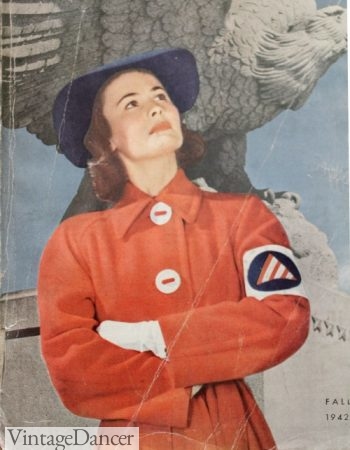
1942 Sears Catalog Cover
The tables turned in the 1940s. WWII began in 1939 and fashion took on a new role. Men’s fashion stopped progressing until after the war – a reflection that most men were serving in uniforms instead of enjoying life at home.
Women’s fashion echoed men’s traditional clothing with man-tailored dresses, coats and hats. These new serious looks were not about an idealized life, but about supporting the war effort through fashion. A woman’s duty was to take care of the homefront, both at her household and in jobs previously held by men.
The clothing reflected this practical and conservative time where materials were limited, even after the war ended in 1945. It took until the end of the decade for women to adopt Dior’s New Look that returned women to an ultra feminine silhouette, and for men to adopt a relaxed fit in their clothing.
Let’s begin the 1940s Style Guide series with a more detailed summary of fashion history. First, for women (click here to jump to men):
1940s Fashion for Women
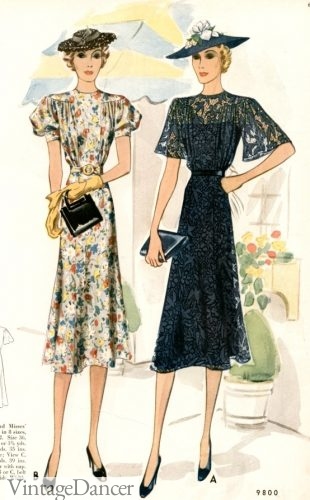
Late 1930s Women’s Fashion
The 1940s were defined by a clean and slim silhouette with a somewhat military feel. Jackets, blouses, sweaters, and skirts were short and close-fitting, all unadorned and with the requisite sharp shoulder pads. Long sleeves were out, dresses were casual, and pants and ‘playsuits’ became everyday attire.
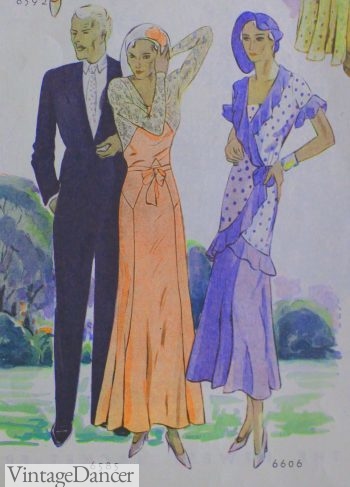
1931 Fashions
Before World War II, Paris was the epicenter of fashion. All of the new styles originated there. Anonymous American designers simply copied the looks coming from France for their wealthy clientele or for stores. The 1930s will be remembered for their glamour, despite the Depression.
Hollywood starlets were clothed in long, draping, flowing gowns made of satin, crepe, silk, and velvet. Dresses and gowns began to be bias cut, meaning the fabric was cut diagonally, allowing it to cling to curves. Coco Chanel brought the day suit into fashion, with a fitted jacket and a long skirt. Fur was the most wanted luxury item.
After Germany took over Paris in 1940, many of the designers closed their fashion houses, some fleeing the country. Those that did stay didn’t see their styles leave the country. The rest of the world was left to come up with their own styles. New York took over, creating a look that was dominated by the war going on across the ocean.
A lot of the materials normally used for clothing became scarce during the war. Wool was used to make uniforms and coats for the soldiers. Leather was needed for their boots. Silk, normally used to make dresses, undergarments, and stockings, was turned into parachutes and waterproof maps. Metal and various chemicals were needed to make just about everything for the war effort.
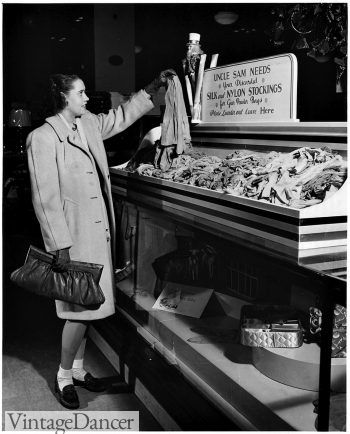
1942, a woman donates her silk stockings to be made into parachutes. She wears socks instead.
Civilian clothing had to resort to using new materials. Nylon, created by DuPont and introduced in 1938, replaced silk for women’s items until it began to be used for the same purposes as silk for the war. American cotton began to take over as a casual fabric of choice.
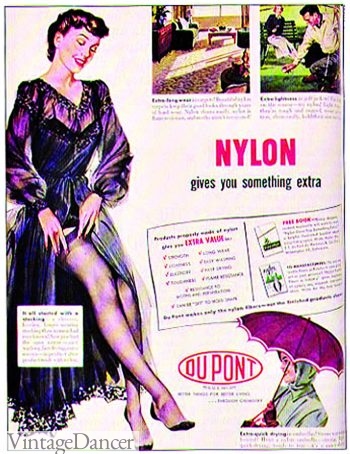
1949 Nylon Stockings Ad
Wool blends were introduced to save wool for military uses, and the synthetic fabric rayon became the most widely used fabric of the time. A softer, silkier version was used for day dresses, and a thick version replaced wool for suits and coats. ‘Vinylite’ could be used instead of leather, and other forms of plastic were used for all kinds of applications.
Aside from breakthroughs in man-made materials, fashions of the day were most affected by the governmental clothing restrictions put in place for the duration of the war. The very silhouette that dominated the ’40s was a casualty of war.
In Britain and elsewhere in Europe, ration coupons for clothing were given out on top of the restrictions, and they didn’t go far. The United States avoided the coupons by putting strict rules in place for manufacturers. The only clothing item that was rationed were leather shoes starting in 1943, and they were only available in black, white, navy and brown.
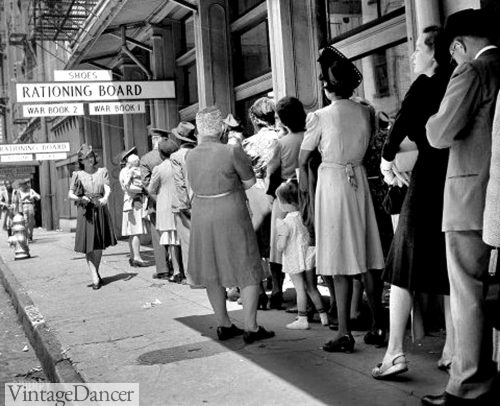
March 1943. New Orleans, Louisiana. Line at rationing board
The United States Production Board put into place ‘Limitation Orders,’ order L-85 governing women’s clothes, which were in effect until 1946. These restrictions were much less severe than in Europe, but still greatly limited what clothing was to look like.
The length and width of blouses, skirts and dresses was restricted, as was sleeve length and hip width. The amount of pockets, buttons, pleats, and seams was dictated, and most decorations were not allowed. This came to be known as the ‘no fabric on fabric’ rule.
The colors of fabrics were set each season to conserve chemicals, so only a handful of patriotically named hues were available.
The heels on women’s shoes could only be 1 ½ inches high.
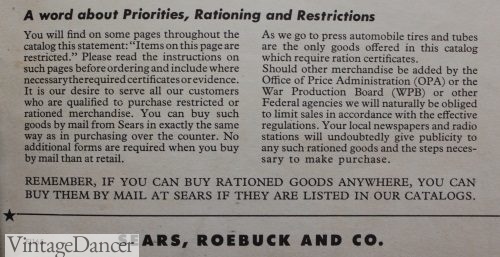
1942 Sears noticed about rationing
All of this interference resulted in a slim, uncluttered look. Skirts were shorter and tighter than anyone was used to, and shirts and jackets were plain and practical.
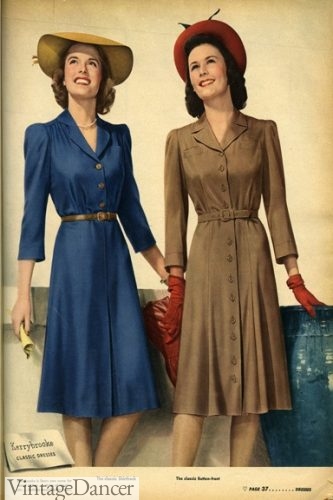
Simple, practical, 1940s shirtwaist dresses
As the prices of clothes soared due to the shortages, they had to last longer and go further. Pieces were extremely well-tailored and the styles started to work for a multitude of occasions.
Although eveningwear was still made and worn, people began to dress more casually in restaurants and theaters.
Versatile separates and sportswear took over, and women began to wear pants as a safety precaution in the factories they were working in.
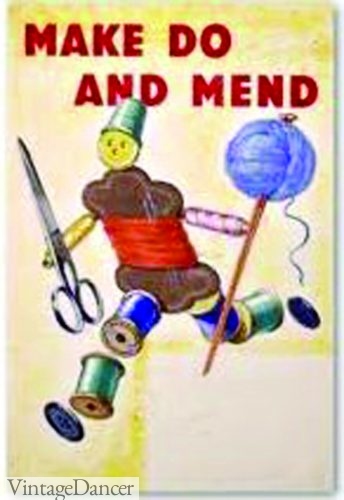
Make do and Mend booklet
Home sewing became popular. In Europe, fabric could be had for fewer coupons than a ready-made garment. In the United States, pattern sales skyrocketed. Citizens were encouraged to mend old clothes, recycle old fabrics into new garments, and combine dresses to make new ones.
Pamphlets with titles like ‘Make and Mend,’ and ‘Make It Do Until Victory’ showed women how to fix and care for their clothes to make them last, and to make them from other household items like blankets and curtains. Here is a book on Make-overs from Coats and Suits.
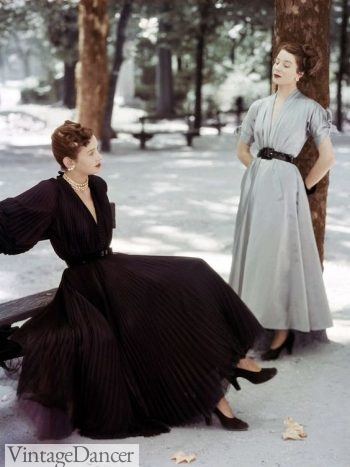
1947 Dior’s New Look
The plain and functional styles lasted throughout the war. When U.S. restrictions were lifted in 1945 and ’46, women continued to wear their war-time garb.
Colors did return to wardrobes, softer and brighter, and skirts got a little bit longer and more flouncy.
In 1947, Paris designer Christian Dior showed his debut collection, soon to be dubbed the ‘New Look,’ which was the total opposite of the severe styles of the war. The silhouette was soft, an extreme hourglass figure achieved with a corset and bust and hip padding, and the skirts were enormous confections of fabric.
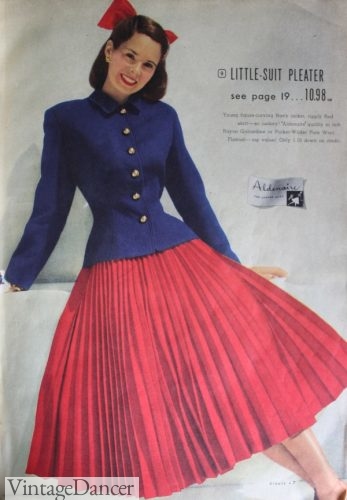
1948 red and blue skirt and jacket
The New Look didn’t take off in the United States. Women felt that Parisian designers had acted as though no war had taken place, while they sacrificed their wardrobes for the war effort. However, most were also ready for a change.
As soldiers came back, women stopped working and returned to new homes and cars in the suburbs. The economy prospered, and clothing manufacture became cheaper and easier thanks to new methods devised for the war.
New York and California remained in the fashion game, and American designers started to be known by name. Eventually, women adopted the New Look that would become the style of the ’50s.
1940s Women’s Fashion History
- An intro to 1940s fashion history
- 1940s Women’s Fashion – Start here and learn all about 1940s Fashion for Women
- 1940s Fabrics and Colors- Learn what colors and types of fabric were common in the 1940s
- 1940s Dresses – 10 common styles worn in the 1940s
- 1940s Day Dresses – Learn about the different styles of 1940s day dresses
- 1940s Shirtwaist Dresses – Learn about and shop for this popular ’40s dress
- 1940s Suits – Women’s Victory Suits
- 1940s Tops and Blouses – All styles of 1940s women’s tops and blouses
- 1940s Sweaters & Cardigans – Staying warm with knits
- 1940s Women’s Coats & Jackets
- 1940s Skirts – From simple A-line skirts to fun dirndl skirts
- 1940s Formal Dresses – Learn about formal dresses, prom dresses, and cocktail dresses
- 1940s Women’s Pants – Learn about and shop for 1940s and 1950s style pants & overalls for women
- 1940s Rompers and Shorts – Summer playsuits, shorts and pedal pushers
- 1940s Swimsuits history – Learn all about fabulous swimwear in the 1940s
- 1940s Shoes – Learn about and shop for 1940s style ladies’ shoes
- 1940s Stockings – Seamed stockings and socks history
- 1940s Working Women’s Clothes – Rosies, shop girls and nurses
- 1940s Zoot Girls – History of the urban Zoot Suit style
- 1940s Teenage Girls’ clothing – Trends and styles worn by teens
- 1940s Lingerie History – A look at the types of bras, girdles, and slips
- 1940s Sleepwear – Nightgowns, pajamas, robes, and red jackets
- 1940s Hairstyles for Women – A variety of classic hairstyles through the decade
- 1940s Hairstyles for long hair – Tips on creating a 1940s hairstyle with long hair
- 1940s Hair Snoods – Make or buy a 1940s hair snood and keep your hair in place
- 1940s Hat Styles – A History of over 20 popular hat styles, with pictures. See Hair Accessories too
- 1940s Jewelry Styles – Popular jewelry styles and trends
- 1940s Sunglasses – Women’s sunglasses and eyeglasses
- 1940s Handbags – Purses, day bags and evenings bags
- 1940s Women’s Accessories – Belts, gloves, head scarves
- 1940s Wedding Dresses – History of the bride’s wedding gown
- 1940s Makeup History and Tutorial – Also where you can buy 1940s makeup
- Plus Size 1940s Fashions – History of full figure clothing in the 1940s. Check out our fashion advice for plus sizes as well
- Fashion advice for the petite woman and the tall woman
- Where to shop for repro and vintage inspired 1940s clothing
- 1940s Outfit Ideas – 16 looks you can create
- 1940s Casual Outfit ideas – Casual, sporty looks for summer
- 1940s Fall and Winter Outfits
Shop 1940s Clothing – New, inspired and reproduction
- Dresses and plus size dresses
- Pin Up Dresses and Sailor Dresses
- Evening Gowns and Wedding Dresses
- Skirts
- Pants and Trousers
- Shorts and Rompers
- Tops and Blouses
- Sweaters
- Coats and Jackets
- Swimwear
- Shoes – more flats, boots, sandals, and wide sizes
- Stockings and Lingerie
- Accessories – gloves, belts, and headscarves
- Hats
- Sunglasses and Eyewear
- Hair Accessories
- Makeup Guide
- Jewelry
- Sewing Patterns
- Costumes – Halloween and Party
- Children’s Clothing
- 1940s Clothing and Shoes in the UK
1940s Men’s Fashion History
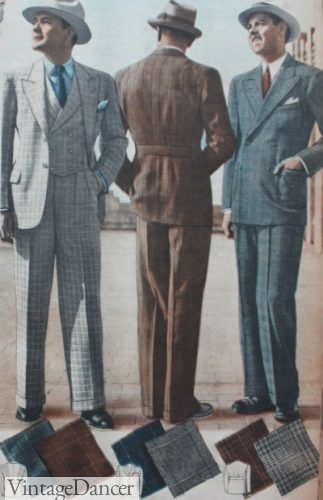
1937 men’s suits
1930s men’s clothing, either for day, sport, or evening were styled to make a man feel “larger than life.” During the 1941-1945 WWII era, fabric rations limited cloth to make suits but not style.
The Zoot Suit with its bright colors, baggy legs and long jackets was a complete deviation from the norm. However, that trend was only popular with the young, urban men during the war years. Most men chose basic men’s suits that haven’t changed dramatically since the beginning of the century. There were, however, a few features that made a suit style unique to the 1940s.
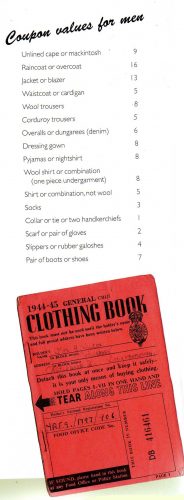
Men’s L-85 restrictions and rationing book as pictured in Forties Fashion by Walford
The war board placed restrictions on men’s clothing just as they did for women. The restrictions were not as dramatic as they were for women.
Suit pockets could not have flaps, trousers could not be more the 19 inches around or be cuffed, and suits were sold without vests (waistcoats).
The cuffed look was so popular that men quickly figured out you could purchase longer length pants and cuff them at home.
The double breasted suits were forbidden during the war except for formal occasions such as weddings. Most men’s kept their clothing from the 1930s and wore them through the early ’40s war years. Tailors became skilled at repairing or repurposing double breasted suit jackets from the 1930s into single breasted jackets or sport coats. It was a sign of support for the war to be seen in your pre-war suits.
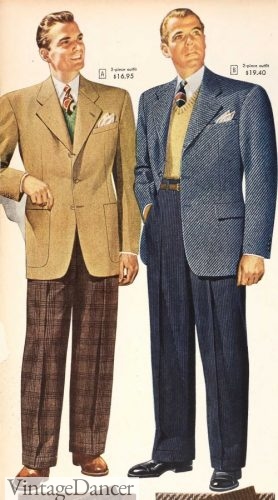
1944 sport coat outfits
In Britain the clothing restrictions were harsher. Jackets could not have pleated backs, metal zippers or buttons, feature raglan sleeves, or have half-belts. Zippers in flys, called front fly fasteners, were allowed, although button flys were preferred and easier to obtain materials.
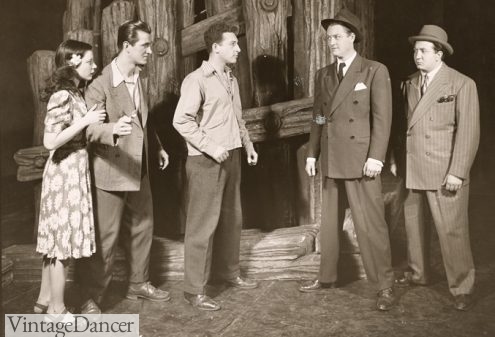
1941 actors rehearsing- both pre-war suits and casual clothing
War time clothing influenced men’s fashion design after the war by coping or modifying uniforms into civilian clothes. Trench coats, bomber jackets, knit undershirts, pea coats, chino pants, and aviator glasses all have roots in WWII military clothing.
With so much military surplus available after the war, civilians would buy and wear military clothing for several more years.
The improvement in machinery, textiles, and manufacturing of military clothing made post war ready to wear civilian clothing a booming industry. The quality and eventually affordability of ready made clothing gradually put local tailors and seamstresses out of business.
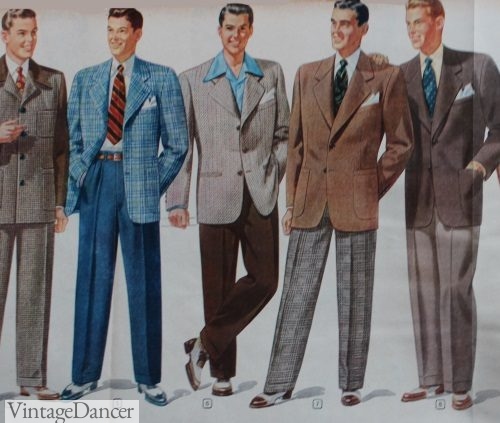
1948 Men’s Semi Casual Fashion
The biggest influence war time restrictions had on men was the further introduction of casualness.
After the war, the need for suits to be worn at all times was replaced by more causal sporting attire. Collarless knit tee shirts, open collar dress shirts, ascot ties, slip on loafers, and sandals in summer became the everyday man’s dress code.
Men were tired of scratchy uniforms and confining suits. The freedom casual clothes brought to men was a big sigh of relief.
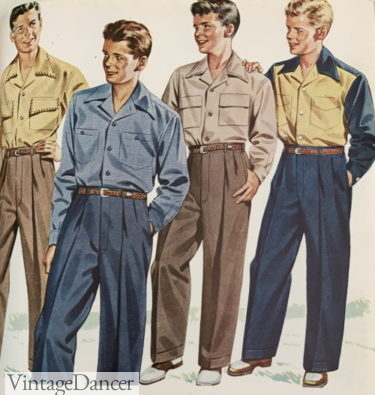
1948 casual clothes for teens
Ironically, the very clothing that caused such turmoil during the war years, the Zoot Suit, was the single piece of fashion that influenced men’s post war clothing. Longer, looser jackets, double pleated pants, big hats, and even wide ties made their way into late ’40s men’s fashions. Men were eager to put the war behind them and embrace the clothing they were previously forbidden to wear.
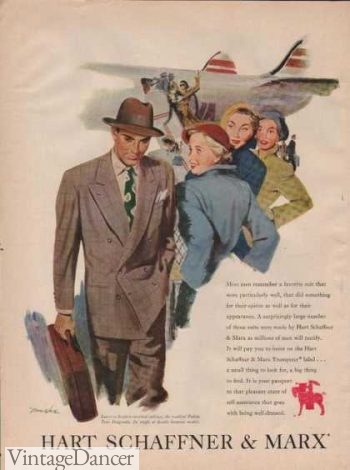
1949 the suits was still wide and baggy but more relaxed than earlier years.
1940s Men’s Fashion History
- 1940s Men’s Fashion – A detailed overview of all areas of men’s fashion in the 1940s.
- 1940s Men’s Suits – Learn about 1940’s men’s suits and clothing. Tips on creating your own look.
- 1940s Men’s Casual Fashion – Sport coats, shirts, and sweater vests.
- Men’s Outfit Ideas from the 1940s
- 1940s Men’s Formalwear – Dressing in white tie, black tie, summer whites and semi-formal.
- 1940s men’s Workwear & Uniforms – What wore for labor jobs and military positions.
- 1930-1950s Western Wear for Women and Men – Men’s western-style clothing from the 1930s to 1960s.
- 1940s Men’s Shoes – Learn about and shop for 1940s style shoes. Go here to read about Saddle Shoes.
- 1940s Men’s Swimwear – Swim shorts of the 1940s.
- 1940s Pajamas – Women’s and men’s sleepwear, robes and slippers.
- 1940s Teenage Boys’ Fashion – Boys’ and young men’s styles.
- 1940s Dance Shoes for Men – Shop men’s swing and ballroom dance shoes with 1940s style.
- 1940s Hats – Learn about 1940s men’s hat styles.
- 1940s Men’s underwear – Boxers, briefs, long johns, socks, and undershirts.
- 1940s Men’s Accessories – Belt, suspenders, cufflinks, glasses, watches, cane, pocket square, gloves, and scarves.
- 1940s Men’s hairstyles and facial hair – Common styles, trends, and grooming products.
- 1940s Groom Clothing – 1940s wedding attire for grooms.
- 1940s Men’s Costume Ideas – Classic 1940s look you can re-create.
- Where to shop for men’s vintage inspired and reproduction clothing. Go here for specifically 1940s men’s repro clothing.
1940s Men’s Style Clothing
- Suits and Zoot Suits
- Tuxedos
- Pants and Trousers
- Shirts and Sweaters
- Vests
- Coats and Jackets
- Hats
- Shoes
- Accessories
- Neckties
- Suspenders and Belts
- Swim Trunks
- Costumes – Halloween and Party
- Men’s Sewing Patterns
- Men’s Clothing in the UK
- Reproduction Men’s Clothing
More 1940s Fashion History Resources
Research for the 1940s Style Guide series involved years of gathering information from books, magazines, catalogs and online sources. Here are a few of the most useful ones:
BOOKS
- Forties Fashion: From Siren Suits to the New Look by Jonathan Walford
- Esquire’s Encyclopedia of 20th Century Men’s Fashions Hardcover by O.E. Schoeffler
- History of Men’s Fashion by Farid Chenoune
- Reminisce Life in the Fantastic ’40s
- Fashions of a Decade: The 1940’s 1992, Facts on File, Inc. by Patricia Baker
- Vintage Fashion: Collecting and Wearing Designer Classics by Emma Baxter-Wright
- 20th Century Fashion by Valerie Mendes and Amy De la Haye
- Everyday Fashions of the Forties As Pictured in Sears Catalogs JoAnne Olian
- Decades of Fashion Tandem Verlag by Harriet Worsley
More books in this list of Vintage Fashion History Books.
WEBSITES
- http://www.centuryinshoes.com/decades/1940/1940.html – A brief illustrated history of 1940’s shoes
- http://www.headoverheelshistory.com/1940.html – A Research project turned history lesson on shoes
- http://www.1940s-fashions.co.uk/ (UK) A very nice collection of fashion plates and advertisements feature fashion from the 1940’s
- www.thepeoplehistory.com/40sclothes.html – An interesting look at fashion and how much clothing really cost
- www.womeninwwii.com – A site all about women who served during WW2 in the 1940’s
- Vintage Fashion on Facebook– Where to learn, shop and connect with others
Even more resources can be found in this article: How to Research Fashion History.
Debbie Sessions has been teaching fashion history and helping people dress for vintage themed events since 2009. She has turned a hobby into VintageDancer.com with hundreds of well researched articles and hand picked links to vintage inspired clothing online. She aims to make dressing accurately (or not) an affordable option for all. Oh, and she dances too.